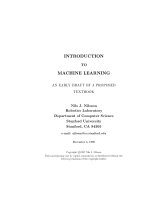Bai 01 introduction to machine learning
Bạn đang xem bản rút gọn của tài liệu. Xem và tải ngay bản đầy đủ của tài liệu tại đây (3.76 MB, 51 trang )
CIS 419/519
Introduction to Machine
Learning
What is Machine Learning?
“Learning is any process by which a system improves performance from experience.”
- Herbert Simon
Definition by Tom Mitchell (1998):
Machine Learning is the study of algorithms that
•
•
•
improve their performance P
at some task T
with experience E.
A well-defined learning task is given by <P, T, E>.
3
Traditional Programming
Data
Program
Computer
Output
Machine Learning
Data
Computer
Program
Output
4
Slide credit: Pedro Domingos
When Do We Use Machine Learning?
ML is used when:
•
•
•
•
Human expertise does not exist (navigating on Mars)
Humans can’t explain their expertise (speech recognition)
Models must be customized (personalized medicine)
Models are based on huge amounts of data (genomics)
5
A classic example of a task that requires machine learning: It is very hard to say what makes a 2
6
Some more examples of tasks that are best solved by using a learning
algorithm
•
Recognizing patterns:
–
–
–
•
Medical images
Generating images or motion sequences
Recognizing anomalies:
–
–
•
Handwritten or spoken words
Generating patterns:
–
•
Facial identities or facial expressions
Unusual credit card transactions
Unusual patterns of sensor readings in a nuclear power plant
Prediction:
–
Future stock prices or currency exchange rates
7
Sample Applications
•
•
•
•
•
•
•
•
•
•
Web search
Computational biology
Finance
E-commerce
Space exploration
Robotics
Information extraction
Social networks
Debugging software
[Your favorite area]
8
Samuel’s Checkers-Player
“Machine Learning: Field of study that gives computers the ability to learn without
being explicitly programmed.”
-Arthur Samuel (1959)
9
Defining the Learning Task
Improve on task T, with respect to performance metric P, based on
experience E
T: Playing checkers
P: Percentage of games won against an arbitrary opponent E: Playing practice games
against itself
T: Recognizing hand-written words
P: Percentage of words correctly classified
E: Database of human-labeled images of handwritten words
T: Driving on four-lane highways using vision sensors
P: Average distance traveled before a human-judged error
E: A sequence of images and steering commands recorded while observing a human driver.
T: Categorize email messages as spam or legitimate. P: Percentage of email messages
correctly classified. E: Database of emails, some with human-given labels
10
Slide credit: Ray Mooney
State of the Art Applications of Machine Learning
11
Autonomous Cars
•
Nevada made it legal for autonomous cars to
drive on roads in June 2011
•
As of 2013, four states (Nevada, Florida, California, and
Michigan) have legalized autonomous cars
Penn’s Autonomous Car
(Ben Franklin Racing Team)
12
Autonomous Car Sensors
13
Autonomous Car Technology
Path
Planning
Laser Terrain Mapping
Learning from Human Drivers
Adaptive Vision
Sebastian
Stanley
14
Images and movies taken from Sebastian Thrun’s multimedia w e bsite.
Deep Learning in the Headlines
15
Deep Belief Net on Face Images
object models
object parts
(combination of
edges)
edges
pixels
16
Learning of Object Parts
17
Training on Multiple Objects
Trained on 4 classes (cars, faces, motorbikes, airplanes).
Second layer: Shared-features and object-specific
features.
Third layer: More specific features.
18
Scene Labeling via Deep Learning
19
Inference from Deep Learned Models
Generating posterior samples from faces by “filling in” experiments
(cf. Lee and Mumford, 2003). Combine bottom-up and top-down inference.
Input images
Samples from
feedforward Inference
(control)
Samples from
Full
posterior inference
20
Machine Learning in Automatic Speech
Recognition
A Typical Speech Recognition System
ML used to predict of phone states from the sound spectrogram
Deep learning has state-of-the-art results
# Hidden Layers
Word Error Rate %
1
2
4
8
10
12
16.0
12.8
11.4
10.9
11.0
11.1
Baseline GMM performance = 15.4%
[Zeiler et al. “On rectified linear units for speech recognition” ICASSP 2013]
2
1
Impact of Deep Learning in Speech Technology
22
Types of Learning
23
Types of Learning
• Supervised (inductive) learning
–
Given: training data + desired outputs (labels)
• Unsupervised learning
–
Given: training data (without desired outputs)
• Semi-supervised learning
–
Given: training data + a few desired outputs
• Reinforcement learning
–
Rewards from sequence of actions
24
Supervised Learning: Regression
• Given (x1, y1), (x2, y2), ..., (xn, yn)
• Learn a function f (x ) to predict y given x
– y is real-valued == regression
9
8
7
6
5
4
3
2
1
0
1970
1980
1990
2000
2010
2020
26
Supervised Learning: Classification
• Given (x1, y1), (x2, y2), ..., (xn, yn)
• Learn a function f (x ) to predict y given x
– y is categorical == classification
Breast Cancer (Malignant / Benign)
1(Malignant)
0(Benign)
Tumor Size
27









